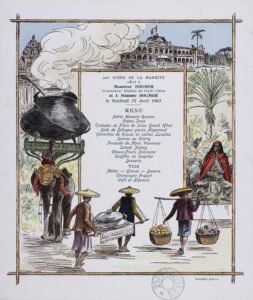By Michael Garval (Regular Contributor)
What’s in the big pot or marmite, in this 1901 French illustrated menu, with its colonial Indochinese setting? Maybe pot-au-feu, the celebrated French comfort food of boiled beef and vegetables? Or perhaps phở (pronounced “fuh”), the celebrated Vietnamese comfort food of beef broth with rice noodles? And what might such possibilities tell us, about both culinary and colonial history?

Franc-Lamy (Pierre Franc Lamy, known as) banquet menu, April 19, 1901, 222e Dîner de la Marmite, offert à Monsieur Doumer, Gouverneur Général de l’Indo-Chine, et à Madame Doumer (Bibliothèque Historique de la Ville de Paris).
Mystery Marmite
Marmite derives from an Old French word meaning “hypocritical,” because the deep, covered pot coyly hides its contents. La Marmite was also an exclusive turn-of-the-century Parisian literary and artistic association that held regular banquets, whose handsomely illustrated menus would incorporate emblematic, enigmatic marmite motifs.
Pierre Franc Lamy illustrated this particular menu for a dinner honoring then Colonial Governor of Indochina and future French President Paul Doumer. The central bill of fare, offering classic French banquet food and fine wine, contrasts with the surrounding Indochinese imagery. Indeed the whole menu juxtaposes colonizer and colonized, their worlds, and especially their food.
The governor’s palace, in the distance, could represent power behind the scenes, controlling this colonial realm. But the building seems almost lost in the background. A bustling Saigon street scene dominates the foreground, as porters in native garb carry local foodstuffs, seemingly unrelated to the Gallic fare served Monsieur Doumer.

Souvenir de Saigon. Palais du Gouverneur Général. French colonial postcard of the Governor’s Palace in Saigon, sent in 1902.
An elephant transports a giant, steaming cauldron, the hallmark marmite on each of the association’s banquet menus. But this one’s emphatic curves lend it a far eastern air. Given the pot’s distinctive appearance, placement on a Saigon thoroughfare, and proximity to other homegrown offerings, we infer that it contains local food as well.
Despite the colonial setting, we glimpse the possibility of indigenous food—and people—prevailing. Steam from the marmite, carrying the aromas of local cuisine, already partly obscures the Governor’s palace, promising to erase this colonial icon from view, and prefiguring the faraway power’s exit from the scene a half century later. Perhaps unwittingly, this menu offers a premonitory vision of decolonization.
Still, what’s in the marmite? The menu lists “Petite Marmite Rossini,” a fancified take on homey pot-au-feu, enriched with foie gras, truffles, and demi-glace. But this is a far cry from local street food, and the gigantic pot is far from petite. Wouldn’t it make more sense to imagine this mystery marmite filled with phở?
Faux Phở
Over the past century, in Vietnam and then around the world, phở has come to be seen as the quintessential Vietnamese dish. These days, imitations, interpretations, and bastardizations abound. Hanoi-based French chef Didier Corlou experiments with foie-gras enhanced phở, a latter-day Indochinese Petite Marmite Rossini. Even TV chef Rachael Ray prepares “Phunky BBQ Pho,” repeatedly mispronouncing phở as “faux.” Faux phở indeed: concocted from chicken stock, angel hair pasta, and pork shoulder, and reviled by Vietnamese-American commentators as an affront to their heritage.
So what is phở, and what’s its history? A soup of rice noodles, herbs, and spices in a rich, flavorful beef broth, phở originated in the early twentieth century, in or around Hanoi, in the north. Beef had not figured much before in Vietnamese cuisine, as cattle were largely beasts of burden. But French colonizers demanded steaks and roasts, leaving bones and scraps that thrifty local street food vendors started using for soup. The name phở may even derive from the French feu or fire, as in pot-au-feu. Or it may derive from fen or fun, the Chinese word for noodle, and seasonings like star anise and ginger come from China as well. These influences aren’t surprising, since the Chinese ruled Vietnam for over 1,000 years, long before the French colonized it for less than 100.

TONKIN–Hanoï–Un Coin du Marché. French colonial postcard of a Hanoi street market, sent in 1906.
For the first half century or so of its existence, phở remained a regional specialty, little known outside the north. But with the 1954 Geneva Accords, which split Vietnam in two, nearly a million northern refugees arrived in the south, and began selling their hallmark soup. Phở soon took on the mantle of a national dish for the divided nation. In turn, in the wake of the Second Indochina War, with refugees flung far beyond the country’s borders, the Vietnamese diaspora would spread phở across the globe. For better or worse, phở has now become an international dish, in the same dubious pantheon as pizza, paella, or sushi: ubiquitous, much loved, but oft misconstrued, while purists still prefer the more austere northern version. And certainly in 1901, in our menu’s day, no sort of phở yet existed on Saigon streets, or elsewhere in the south.
Simmering Tensions
Ultimately then the mystery marmite contains no tangible, identifiable dish. Instead, the steaming pot proffers some vague, nostalgic, ahistorical ideal of simple, slow-cooked, homespun goodness, at odds with both the menu’s refined banquet food, and its complicated colonial context of tensions and shifts, exchanges and interconnections. But at the same time as this menu was created, a real dish was emerging, its multi-layered flavors interwoven, over time, with Vietnam’s complex, fraught, fascinating legacy of colonization, decolonization, division, and diaspora. So the next time you tuck into a steaming hot bowl of phở, savor the delicious taste of history.
